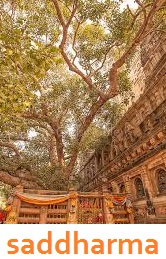All parties concerned accept that Sakyamuni Buddha, or Gautama Buddha, formulated a number of rules for his monks, and that a fair number of rules were added over time, either by Buddha himself or by vinaya masters in later ages.
With 'sangha' we mean the fully ordained Buddhist monks and nuns according tot the orthodox rules contained in the above mentioned vinaya and it's condensed set of rules, the pātimokkha (Pāli) or prātimokhsha (Sanskr.).
The rules on not damaging plants and not killing of animals
The above mentioned Code, or Monastic Discipline, contains a 'first category', rule that forbids monks and nuns to damage plants. A participant contrasted this rule with a 'third category' rule on not killing animals. Why should damaging plants be a more serious offence than the killing of an animal, he asked.
'First category' is a grave rule or offence; 'third category' is less grave.
Except for the three months rainy season the Buddha was continually on his way with a large following of monks. There must have been some roads in that part of India that he criss-crossed, but not too many; compare it large parts of Yorkshire and Scotland.
Now, in order to prevent the brotherhood trampling the freshly planted paddy and other crops, Buddha decided that during the three months of the rainy season one should not travel, and that during the rest of the time too the monks were not allowed to damage the crops — 'plants' says the text.
It would have been unthinkable that a group of monks, just after sunrise, would stand outside the gate of this particular farm, alms bowl in hand, expecting the farmer's wife to ladle in some of those delicacies they destroyed just the day before. That is why not damaging plant life is a first degree offence.
Has it relevance for today's sangha? It depends on where this sangha lives. Generally we may say that the relevance is no longer there.
Then why is it that killing animals is a less grave offence than damaging crops?
Monks and nuns were not supposed to prepare their own food. Whatever they ate, and eat in the case of Theravāda monastics, was food donated by the laity. They therefore had, and have, no worries about slaughtering a chicken or a pig. Therefore the rule on not killing animals was not laid down with respect to preparing food, but with respect to defending oneself against the attacks of wild animals. One of the other rules says that a monk was allowed to defend his life when under attack, unless he would be an Arhat, a fully enlightened being who in this life 'had done what had to be done'.
Killing an animal therefore was and is prohibited, but in case a monk had to kill this tiger in order to save his own skin the penalty would not be so very heavy. He had to confess, repent, and in some cases he had to make it up by doing something exceptionally good for other, living, animals.
Although the practise on not preparing one's own food but going on almsround instead today only is upheld within the Theravāda tradition, and not within the Mahāyāna, the rule on not killing animals holds good, were it only because both the Theravāda and Mahāyāna sūtric literature is adamant on protecting all life as a means of obtaining enlightenment resp Buddhahood.
|

